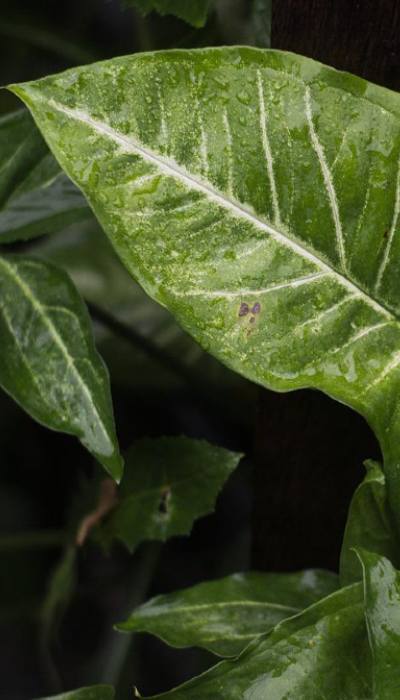Arrowhead plants, or Sagittaria spp., are hardy aquatic perennials native to North America and Asia, with species like S. graminea growing in the U.S.
The arrowhead grows in small bodies of water like ponds, puddles, and marshes; the leaves grow underwater, while the flowers rise above the surface on long stems above the water’s edge.

Soil Preparation
Arrowhead plants grow well in moist soil that has been amended with compost. It is best not to plant them where they have grown in the past as this could lead to overcrowding and stunted growth. If you are planting a new bed, mix the following together: one part garden compost, one part topsoil, and one part sand.
Add organic fertilizers such as manure or compost tea. Dig a hole two feet deep and two feet wide for each plant (one inch less than the height of the pot). Place your arrowhead plant in its hole, making sure that all of the roots are covered with soil. Fill any gaps around the edges of your plant with soil and then water thoroughly so that it settles into place.
Planting your Arrowheads

- Obtain an appropriate-sized pot for the plant.
- Fill the pot with a 50/50 mixture of potting soil and compost.
- If you want to add fertilizer, do so now and mix it well with your soil mixture. Add enough water to wet the soil and make it moist but not soggy.
- Place two pieces of gravel or marbles at the bottom of your pot to act as drainage material.
- Place one sprig of arrowhead plant (about two inches) on top of the gravel or marbles, pushing down slightly into moistened soil until the roots are covered by moist dirt.
- Cover with more moistened soil and push gently until full depth is achieved – about four inches from the top surface; water again before covering completely with soil if needed
- Water thoroughly after planting
- Arrowheads should be planted out of doors in late summer or early fall
- In warmer climates, they can also be grown indoors during the winter months
- They will grow best in full sun
- Plant with the stem pointing up
- Keep the soil moist
- Pinch off any blossoms that form while they’re still small
- Fertilize once per month
- A few plants can become invasive
- These plants prefer sandy soils
- They will need plenty of water
- But don’t let them sit in standing water
- Be careful with the amount of sun they receive
- Too much heat can cause their leaves to yellow
- When watering
- Make sure all their root system gets wet
- In cold areas
- Provide a windbreak
- Cut back on watering
- Be sure they get good air circulation
What Water Do They Need?
Arrowhead plants need a lot of water, but not during the winter. During the winter they should be watered sparingly and allowed to dry out in between watering. They also need lots of suns and rich soil with plenty of organic matter in it.
They like a cool climate and cannot tolerate frost or ice on their leaves, so if you live somewhere that gets cold winters then make sure that the soil is raised up off the ground or put some kind of insulating material around them for protection. The good news about these tough little plants is that as long as they are planted properly, have enough water, and get enough light, arrowheads will grow just about anywhere!
How Can I Care for Them?
To care for your arrowheads, you need well-draining potting soil, which is rich in organic matter. The soil should be moist but not wet. The pot or container should have good drainage holes and needs to be deep enough for the roots to spread out.
Arrowhead plants do well in partial shade. They are very sensitive to cold temperatures, so they should not be planted outdoors until all chance of frost has passed and the temperature consistently stays above 50 degrees F. They can also be grown indoors in pots as long as they are given sufficient light and warmth.
Do They Come Back Year After Year on Their Own?
Arrowhead plants are perennial. This means that they grow back year after year on their own. They will not, however, come back the same size as they were the previous year. They may be smaller or larger than before depending on how much rain and sun they received during the previous growing season. If you want an arrowhead plant to grow to its full size, it is best not to trim it at all during the summer months of June through September when it is producing leaves and stems.
Additional Information About This Plant

An arrowhead plant is a type of succulent. They are not difficult to grow, but they do need a little bit of extra care. The most important thing that you will need to know about these plants is how much water they require. They are relatively easy and forgiving if you forget their watering schedule, but they can’t go without water for more than three days at a time.
If you give them too much water, the excess will run out of the bottom of the container and make a mess. You should aim for no more than an inch or two per week in your pot. When it comes to fertilizer, they don’t really need any unless you have noticed some yellowing leaves or slow growth rates. In general, they are very low-maintenance plants with few problems!
One problem that people often encounter when growing these plants is root rot due to over-watering. Other common causes of problems include overwatering, underwatering, and a lack of sunlight (they prefer full sun).
Conclusion
Arrowhead plants can be grown in a variety of ways and will tolerate many different soil types. They are also tolerant to drought and can handle freezing temperatures. The easiest way is to plant them from seeds, but if you don’t have any, you can always purchase plants from your local nursery or garden center.
You’ll want a planter that has at least six inches of drainage holes in the bottom so that water doesn’t stay in the container which will rot the roots over time. When growing arrowheads, it’s important not to overwater them as they have very sensitive roots and don’t like wet feet.
Also, check out the latest articles “Pink princess philodendron” and “Anthurium crystallinum“
Hi I’m Bilal Malik, a digital marketing and blogging expert holding years of experience.










